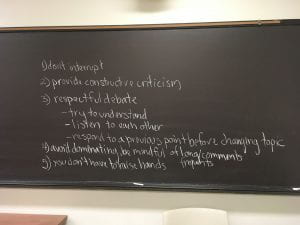As the spring quarter and academic year comes to an end, instructors may be starting to consider which pedagogical practices and tools from remote teaching might still be useful once we are back in a F2F class setting. This week, we talked to Writing Specialist Sarah Bonanno about her use of digital write-ins in the remote writing classroom. Sarah works in the University Writing Program, and she piloted the digital write-ins using the digital write-in toolkit created by Assistant Instructional Professor and Humanities Core Teaching Coordinator Valerie Levan, Assistant Director Ashley Lyons, and Associate Director Linda Smith-Brecheisen. Digital write-ins are an exciting pedagogical tool that could be used in remote courses or easily implemented in F2F classes.
When asked to define digital write-ins, Sarah describes how the group Zoom sessions “give students time and space to just write.” The planned sessions when students are together on Zoom, but working independently on pieces of a writing project for the course, help to build in the important structure that encourages students to write regularly. As Sarah puts it, “We don’t actually focus on how time consuming it can be to write and how a lot of successful writers will form really healthy writing habits” to finish projects. Sarah clarifies that “the write-ins are not a substitute for office hours, it’s not a substitute for seminars, it’s a separate time and place for students to come together and write; they also have the added support of being with other members of their class in a shared activity.”
In terms of the pedagogical payoffs, Sarah describes how digital write-ins “give students space to draft and revise” their work. These events help student to see the benefits of writing and revising on a regular basis to create a final product. The digital write-ins can help to build class community, and they offer her as an instructor with informal opportunities to engage with students and get to know them better. The digital write-ins also helped students understand that professional writers work in this way, as Sarah would attend and work on one of her own writing projects alongside students to let them know “students aren’t the only people who carve out designated writing times.”
Sarah points out that write-ins could work well in-person or as virtual activities that are incorporated into otherwise F2F courses: “In-person it could definitely be really exciting to be writing in the same shared physical space, but I also think this could be something from virtual learning that could carry over really well into in-person classes. You don’t have to reserve any space. Students can do it from their own rooms. The bar for entry is really low.”
When asked about ways to set up digital write-ins to be successful in classes, Sarah recommends scheduling digital write-ins at the start of the quarter. She recommends making digital write-ins extra credit or attaching a participation grade to them to increase student buy-in, or even asking students to take over more ownership of the planning of digital write-ins themselves. It’s important, she notes too, to set clear expectations around digital write-ins, and to let students know ahead of time that they are not similar to office hours where they might come with questions. Sarah mentioned that during the write-in itself she always asks students at the start to think of a manageable goal that they might be able to achieve in the time allotted, and then midway through the session they conduct a check-in.
Ultimately, though Sarah has been excited about the pedagogical benefits of the digital write-ins! The write-ins are great because they intersect with some of the most important parts of writing pedagogy in helping students break down writing projects into parts themselves and revise frequently. Sarah concludes, “it’s really a moment for self-directed learning!”
*Are you interested in trying out digital write-ins in your own teaching? Check out the Write-In Toolkit created by by Assistant Instructional Professor and Humanities Core Teaching Coordinator Valerie Levan, Assistant Director Ashley Lyons, and Associate Director Linda Smith-Brecheisen.


